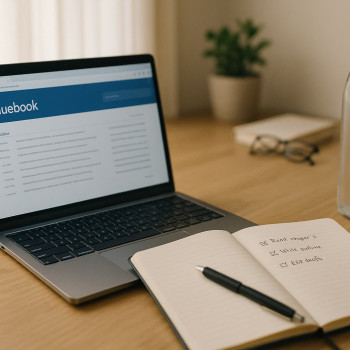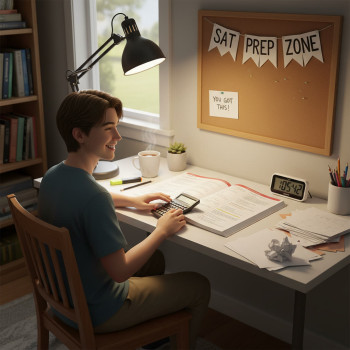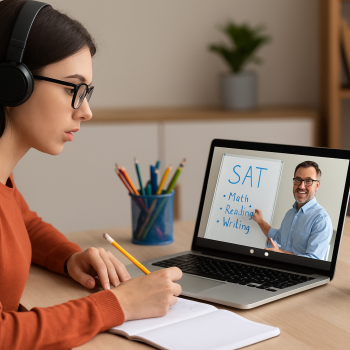Why Distraction Is the Real Test
It’s tempting to think the SAT measures only math and reading skills. The truth? A huge part of test-day success comes down to your ability to focus under pressure. Whether you’re tackling a hard grid-in, dissecting a dense reading passage, or practicing sections on a digital device, distractions chip away at your mental stamina and make even small mistakes cost you points.
If you’ve ever sat down to study with a plan only to find an hour later that you’ve scrolled through social media, answered texts, or reorganized your desk for the third time, you’re not alone. This blog is for that student — the one who wants to turn scattered study time into deliberate, high-impact practice. Expect realistic tactics, small experiments you can try today, and a few ways personalized support (like Sparkl’s tutoring options) can make focus easier and more sustainable.
Start with a Plan: Structure Reduces Willpower Battles
Willpower is finite. One reason study sessions derail is because they depend on willpower alone. Instead, set up structures so you don’t rely on “trying harder.” A clear plan acts like a guardrail: it tells your brain what to do next so you waste less energy deciding.
Create a Simple, Sticky Study Schedule
Students who make a weekly schedule — not just a to-do list — get more done. Here’s a simple framework you can adapt:
- Block 3–5 study sessions per week of 60–90 minutes each (fewer long sessions, more consistent practice).
- Define the focus of each session: one might be “No-calculator Math: geometry problems,” another “Reading: paired passages,” and another “Official practice test review.”
- Schedule high-focus tasks for when you feel mentally sharp — often mornings or just after school for many students.
Pro tip: treat scheduled study sessions like appointments. Put them on your calendar and set one reminder 10–15 minutes before to prepare mentally.
Use Short, Focused Blocks (with a Twist)
Long sessions can burn you out quickly. Instead, try focused intervals with planned breaks. Two popular formats work well:
- Pomodoro-style: 25 minutes focused, 5 minutes break; after four cycles, take a longer break (20–30 minutes).
- Deep-blocking: 50–60 minutes focused, 10–15 minutes break — helpful when you need longer stretches for reading passages or full problem sets.
Experiment to find what fits your attention rhythm. Keep a simple log for a week and notice when concentration dips — then tailor your block lengths accordingly.
Design Your Environment: Make Focus the Default
Your environment either encourages focus or invites distraction. The good news: small changes can create a big difference.
Choose a Dedicated Study Space
It’s less about perfection and more about association. When your brain learns that a certain chair or desk equals study time, it slips into focus faster.
- Keep that space primarily for studying — avoid using it as a lounging or gaming zone.
- Make it comfortable: good lighting, a supportive chair, water nearby, and a clean surface.
- If space is limited, create a portable “study kit” (notebook, timer, pencils) that you only bring out during study blocks.
Remove Visual and Auditory Clutter
Studies show even small background stimuli can reduce cognitive performance. Clear your desk of unrelated items. If ambient noise is a problem, use noise-canceling headphones or low-volume instrumental playlists that help concentration.
Tame Your Devices: Use Technology to Fight Technology
The same phone that helps you study can also dismantle your session in seconds. Rather than wage a losing battle of willpower, use tech tools to create barriers.
Practical, Non-Extreme Device Rules
- Airplane mode or Do Not Disturb during study blocks — allow calls from family if needed, but silence social apps.
- Use site- and app-blockers for the study session time (many free apps and built-in phone features do this). Choose strict blocks during practice tests and more flexible settings during review.
- Place your phone in another room for deep blocks. Out of sight often equals out of mind.
Make Your Computer Work for You
If you practice the Digital SAT on a laptop or tablet, set up a clean, dedicated browser profile or user account for test prep that only contains necessary resources. Close tabs you don’t need and install a minimalist start page that routes you to official practice materials and your current study plan.
Build Habits that Stick: Small Wins Grow Fast
Focus is a skill you can train. It grows through repeated, intentional practice — especially when you celebrate small wins.
Start and End with Rituals
Rituals cue your brain to shift into and out of study mode. Your rituals can be simple and personal:
- Begin with a 60-second review of your goal for the session (e.g., “Complete 10 math problems focusing on rate problems”).
- End with a quick 2–3 minute reflection: what went well, what to tweak next time. This small habit builds metacognition and reduces the chance of drifting off-task.
Reward Real Progress
Don’t wait for the big milestone (like the official test) to celebrate. After a week of hitting scheduled sessions, treat yourself to something small: a favorite snack, an outing with friends, or a guilt-free hour of screen time.
Active Study Beats Passive Browsing
Focus improves when your brain is actively engaged. Swap passive review (re-reading notes) for active strategies that make study time feel purposeful and efficient.
Active Techniques to Try
- Self-quizzing: Cover answers and force recall. This strengthens retrieval — the skill the SAT demands.
- Explain out loud: teach a friend, a sibling, or even an imaginary student. If you can explain it clearly, you understand it.
- Mixed practice: combine reading and math problems in a single session to simulate test conditions and reduce monotony.
Simulate Test Conditions
Nothing reveals true distraction problems like a full timed practice test. When you recreate the environment (timers, no phone, digital test interface), you learn where your attention breaks down and can craft targeted fixes.
Common Distraction Pitfalls and How to Fix Them
Let’s break down typical distraction patterns and realistic counter-strategies.
The “Endless Preparation” Trap
Some students over-prepare as a way to avoid the discomfort of performance. If you find yourself endlessly making study guides but rarely doing timed practice, set a hard rule: for every 2 hours of content review, complete 1 timed practice section.
The “Boredom Shutdown”
If longer sessions devolve into boredom, shorten your blocks, switch subjects mid-session, or add a quick active challenge (a 10-minute speed reading practice or five timed algebra problems) to re-engage your brain.
The “Perfection Paralysis”
Getting stuck on one hard problem or reviewing every detail of an answer can drain an entire session. Adopt the 3-minute rule: if a problem stalls you for more than 3 minutes during practice (unless in a full-test mode), mark it and move on. Return during review when your brain is fresher.
Practical Tools: A Table for Your Focus Toolkit
Below is a quick reference table of tactics, when to use them, and the expected payoff. Try one new tool each week and note changes.
| Tool | When to Use | Expected Benefit |
|---|---|---|
| Pomodoro timer | Short study blocks, high distraction risk | Increases focus bursts and prevents burnout |
| Phone in another room | Deep work or timed practice | Reduces temptation to check notifications |
| Noise-canceling headphones | Noisy household or public study spaces | Improves sustained attention |
| App/site blocker | When digital distractions derail study | Creates a friction barrier to mindless browsing |
| Study ritual (start/end) | Every study session | Faster mental transition into focused work |
Mindset and Motivation: Keep the Why Front and Center
Motivation isn’t a one-time spark — it’s a habit. Connect your daily study to a meaningful why: college choices, scholarship goals, or personal pride. Write that why on a sticky note and place it at your study spot.
Reframe Setbacks as Data
Bad study days aren’t failures; they’re information. If you lose focus, ask: What time of day was it? How long had I been studying? Did I sleep well? Use that data to adjust your schedule rather than beating yourself up.
How Personalized Tutoring Can Reduce Distractions
One reason students drift is unclear next steps. Personalized tutoring, like Sparkl’s 1-on-1 guidance, can keep you accountable and hand you a tailored plan so each study session has a clear objective. When a tutor helps identify your weak spots and builds a roadmap, you’ll waste less time guessing what to study — and more time actually improving.
Benefits to look for in a tutoring relationship:
- Tailored study plans matched to your score gaps and schedule.
- Accountability through regular check-ins and milestone tracking.
- Expert feedback that shortens the learning curve on tricky question types.
- AI-driven insights (if available) that highlight patterns in your mistakes so you can target practice more effectively.
Daily Checklist for a Distraction-Free Study Session
Use this short checklist before every session. It takes under two minutes and protects your focus investment.
- Phone: Do Not Disturb or in another room.
- Materials: Test device charged, scratch paper, pencil, timer ready.
- Goal: One clear objective for the session written down.
- Environment: Light, temperature, and noise checked.
- Break plan: When and what (movement, hydration, snack).
When to Ask for Help
If you’re constantly distracted despite trying these strategies, consider whether stress, sleep, or emotional factors are draining your focus. Reach out to a counselor, parent, teacher, or a tutor. Sometimes accountability and an outside perspective (like a dedicated Sparkl tutor) can uncover patterns you miss on your own.
Putting It All Together: A Two-Week Focus Sprint
Want a quick start? Here’s a two-week plan to kickstart disciplined, distraction-free study:
- Week 1: Establish routines — pick a study space, try Pomodoro blocks, and run three timed practice sections. Log distractions and what you did instead.
- Week 2: Introduce targeted practice — focus on the weakest question types identified in Week 1, simulate one full digital practice test under test conditions, and review with active recall techniques.
At the end of two weeks, review your log. Celebrate wins, refine strategies that failed, and consider adding a personalized tutor if you want faster progress and accountability.
Final Thoughts: Small Choices, Big Results
Beating distraction isn’t about willpower alone — it’s engineering your environment, routines, and tools so focus becomes the path of least resistance. Start small. Try one change at a time. Keep a short log to see what actually moves your score and your confidence.
And remember: you don’t have to do it alone. Personalized tutoring and guidance — whether it’s a weekly check-in, a tailored study plan, or on-demand feedback — can make focus easier and more efficient. If you’re ready to take the next step, consider a tutor who tailors practice to your needs and helps build the accountability that turns good intentions into real improvements.
Quick Takeaway
Focus is a skill you can design. Build routines, use practical tech rules, practice actively, and get help when needed. Over time, disciplined study becomes not a grind, but a reliably productive habit that moves your score — and your future — forward.
Want to Make Focus Easier?
If you’d like a tailored study plan or accountability to stay distraction-free, consider exploring personalized tutoring options with 1-on-1 guidance, tailored study plans, expert tutors, and AI-driven insights to identify patterns in your performance and close gaps faster.
















No Comments
Leave a comment Cancel